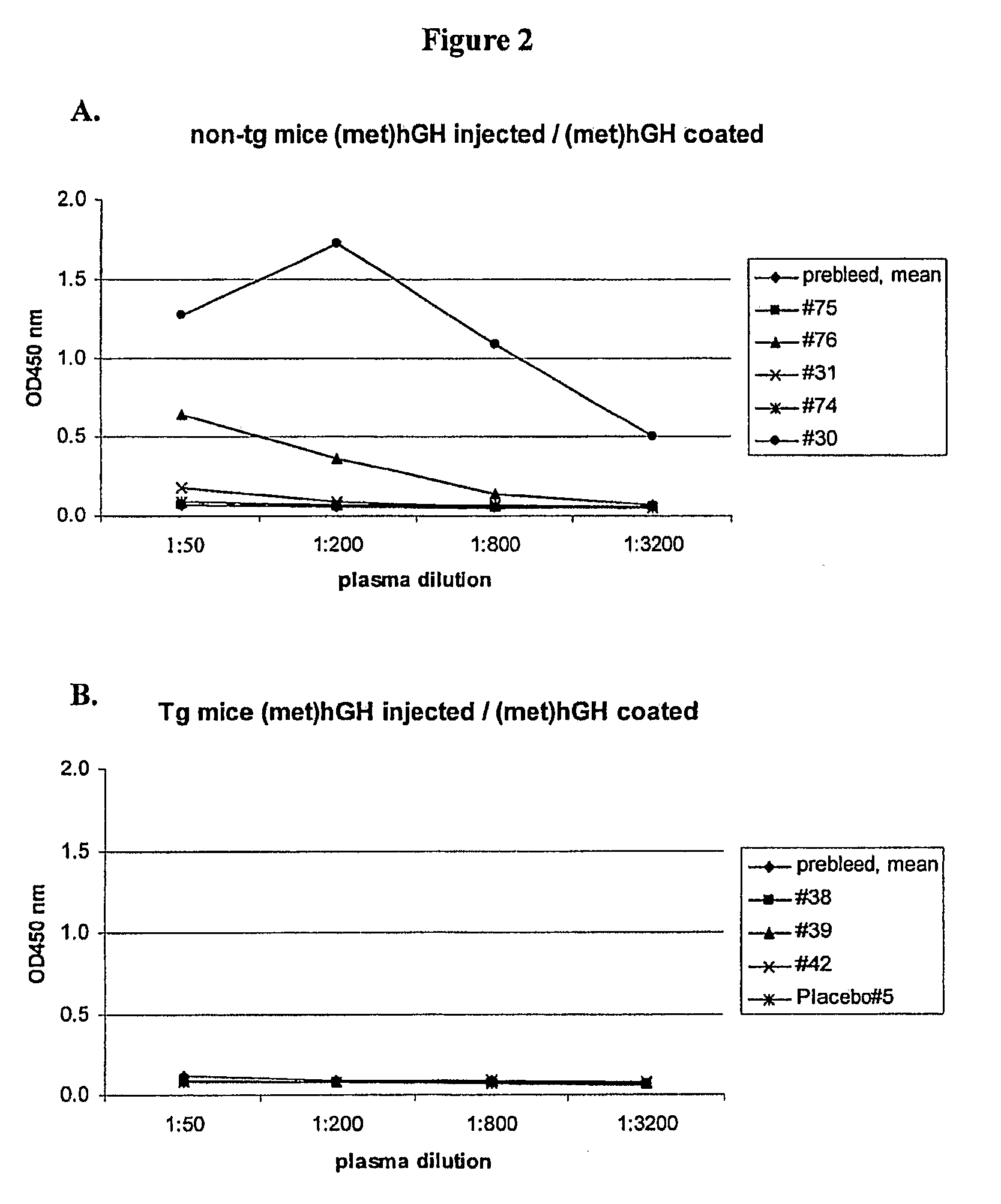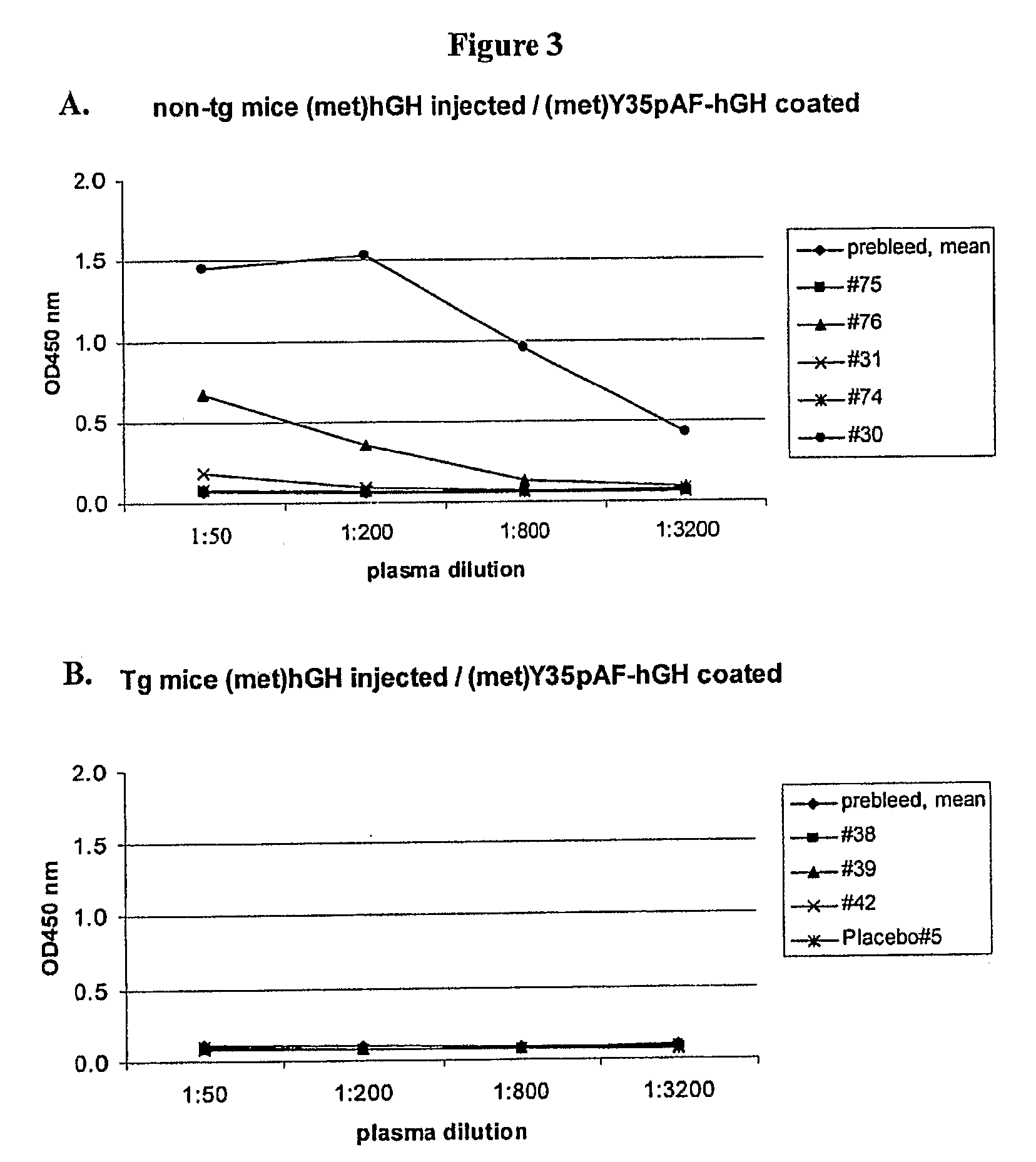Non-Natural Amino Acid Polypeptides Having Modified Immunogenicity
a technology of amino acid polypeptides and amino acids, which is applied in the field of polypeptides, can solve the problems of short pharmacological half-life, difficult to achieve therapeutically useful blood levels of proteins in patients, and limit the efficacy and safety of protein therapeutics in multiple ways, so as to reduce the immunogenicity of polypeptides, enhance the immunogenicity of polypeptides, and reduce the immunogenicity
- Summary
- Abstract
- Description
- Claims
- Application Information
AI Technical Summary
Benefits of technology
Problems solved by technology
Method used
Image
Examples
example 1
[0624]Transgenic mice expressing hGH were used to investigate the immunogenicity of a methionyl hGH polypeptide with a non-natural amino acid substitution and a methionyl hGH polypeptide that is PEGylated at a non-natural amino acid substitution. Sweetser, D. A. et al. in PNAS 1988; 85:9611-9615 and in Genes & Development 1988; 2:1318-1332 describe transgenic mice that express hGH via constructs that fuse portions of the fatty acid binding protein gene with the hGH gene. Two heterozygote breeding pairs of hGH transgenic mice were purchased from The Jackson Laboratory. Primer sets A, C and F amplifying various regions of the hGH transgene were used to determine the presence of the hGH transgene. Mice were scored positive for the hGH transgene when two or more of the primer sets yielded desired PCR products. FIG. 1 shows a schematic illustration of the fatty acid binding protein (FABP)-hGH fusion transgene with the three primer sets. Plasma hGH levels were measured with an ELISA kit a...
example 2
[0632]Para-acetylphenylalanine was not immunogenic when presented in an immunogenic conjugation format to rabbits, as shown in FIG. 22, Panel B. Moreover, p-acetylphenylalanine was shown to be no more immunogenic than native amino acids in inducing the production of rabbit antibodies. De-aminated derivates of Phe, Tyr, p-acetylphenylalanine (pAF), and DNP were coupled to a carrier protein native to the rabbit, rabbit serum albumin (RSA) by the EDC conjugation method. The amino group was removed to prevent di- and tripeptide formation from occurring, and the amino acids were linked to lysine side chains on RSA.
[0633]Three rabbits / group were immunized with 50 ug / animal of the conjugate in incomplete Freund's adjuvant. The animals were boosted twice, and sera were collected at 8 weeks post-immunization. The sera was tested by ELISA against the corresponding KLH-conjugated amino acid. Results for DNP are shown in FIG. 22, Panel A; Phe onFIG. 22, Panel C; and Tyr on FIG. 22, Panel D. The...
example 3
[0634]This example describes one of the many potential sets of criteria for the selection of preferred sites of incorporation of non-naturally encoded amino acids into hGH.
[0635]This example demonstrates how preferred sites within the hGH polypeptide were selected for introduction of a non-naturally encoded amino acid. The crystal structure 3HHR, composed of hGH complexed with two molecules of the extracellular domain of receptor (hGHbp), was used to determine preferred positions into which one or more non-naturally encoded amino acids could be introduced. Other hGH structures (e.g. 1AXI) were utilized to examine potential variation of primary and secondary structural elements between crystal structure datasets. The coordinates for these structures are available from the Protein Data Bank (PDB) (Bernstein et al. J. Mol. Biol. 1997, 112, pp 535) or via The Research Collaboratory for Structural Bioinformatics PDB available on the World Wide Web at rcsb.org. The structural model 3HHR c...
PUM
| Property | Measurement | Unit |
|---|---|---|
| Volume | aaaaa | aaaaa |
| Mass | aaaaa | aaaaa |
| Fraction | aaaaa | aaaaa |
Abstract
Description
Claims
Application Information
 Login to View More
Login to View More - R&D
- Intellectual Property
- Life Sciences
- Materials
- Tech Scout
- Unparalleled Data Quality
- Higher Quality Content
- 60% Fewer Hallucinations
Browse by: Latest US Patents, China's latest patents, Technical Efficacy Thesaurus, Application Domain, Technology Topic, Popular Technical Reports.
© 2025 PatSnap. All rights reserved.Legal|Privacy policy|Modern Slavery Act Transparency Statement|Sitemap|About US| Contact US: help@patsnap.com



